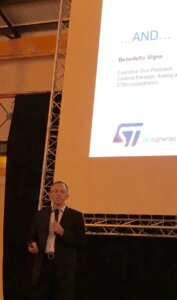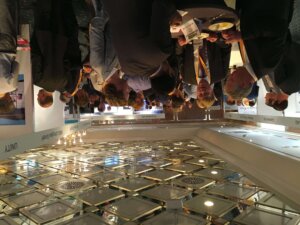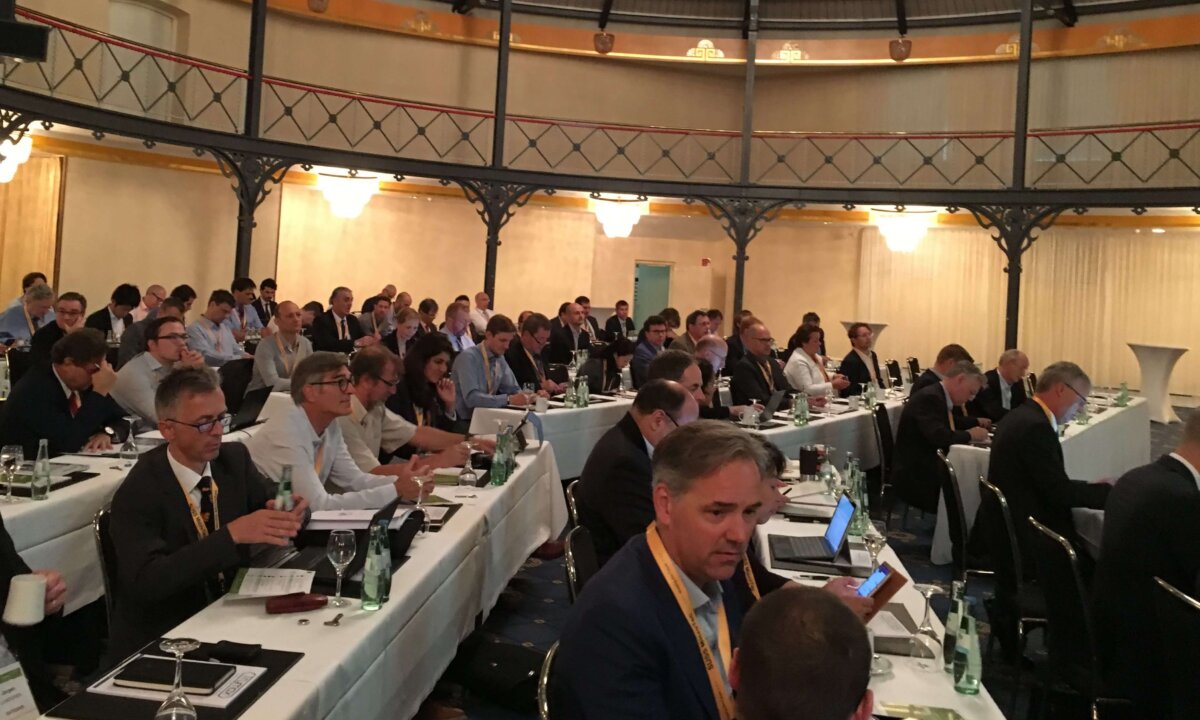After the European MEMS Summit 2016 concluded on Friday afternoon (September 15-16, 2016), one of the attendees asked me which presentation was my favorite presentation. I mulled it over, first declaring it was the Intel presentation by Raji Baskaran, and then Jérémie Bouchaud’s (IHS) presentation. And then it hit me: in all honesty, my favorite presentation was the closing remarks, delivered by Peter Clarke, EE Times. Why? Because for one thing, he made my job a whole lot easier, summing up two days and hitting all the key points in about 15 minutes. Secondly, his words validated many of my own impressions of the discussions. Here are his observations, along with some of mine, and some details mixed in.
Clarke launched into his summary with the words, “Do you feel richer than one year ago?” reminding us all that at the inaugural MEMS Summit, which took place last September in Milan, Sean Ding, of Huawei, declared he wanted to make us all rich, if we could speed up the sector.
“I don’t have a sense that the industry has speeded up. But I’m still excited by this conference,” said Clarke. “The industry has taken a breath and is getting ready for then next wave. What’s the next killer app? If you know, you’re not telling.”

In my opinion, Clarke hit the nail squarely on the head with that opener. Indeed, speeding up time-to-market wasn’t this year’s theme. Rather, it seems like this year’s event was about a reality check, beginning with Bouchaud’s presentation, as well as a look at success in the European region, where, just like the theme of this year’s summit, MEMS makes every market smarter. “It (the theme) seems like a powerful idea, and it is achievable through the courage of our convictions,” said Clarke, pointing to ST Microelectronics approach of diversifying and placing bets on all possible areas where the next big thing will come from. Benedetto Vigna, ST Micro, confirmed this philosophy in his keynote, saying that the word “AND” describes the needs of IoT: MEMS AND analog AND connectivity.
As Laith Altimime, president, SEMI Europe pointed out; four major EU players connect the global MEMS and sensors ecosystem. They are Bosch, ST Microelectronics, Infineon, and NXP, and they were all well represented at this summit.
Weighing in on Automotive, Medical Wearables, and the IoT
The market analysts weighed in on key market drivers. Eric Mounier, Yole offered healthy expectations for medical and the automotive market. He said while the market for smart phones/portable applications is leveling out, the auto industry is still hungry for sensors, and autonomous vehicles offer new opportunities. He predicted that by 2045, over 70% of vehicles sold will have autonomous capabilities.
While the line between consumer and medical devices blurs with bioMEMS, Mounier says this trend can carry the bioMEMS industry “across the gap from medium to large volumes, enabling significant cost decreases.”
Michael Alexander, Roland Berger, GmbH, provided some tips on how to successfully become a leader in a competitive MEMS and sensor technology landscape and predicted that we might “break the Internet” With 50B connected devices by 2020. Alexander presented the IoT dilemma, that despite market growth; manufacturers are struggling with price decreases. There is strong unit demand, but also competition between suppliers as demand increases.
Bouchaud, however, offered a reality check about the Internet of Things (IoT). “We aren’t going to have a trillion sensors like people thought. It will be more like 10s of billions,” he said. He also explained that the IoT is about re-using existing sensors and finding new use cases. The trend now is that MEMS and sensor solutions developed for consumer applications will be re-designed for automotive and industrial applications.
Bouchaud talked about smart homes, smart cities, and smart agriculture, all as opportunities for the market. “We cannot exclude that there will be killer applications, but will they make a significant impact like the smartphone?” he asked. As Clarke summed it up, there are lots of interesting use cases, but not a lot of traction yet.
On a more positive note, Alexander offered encouragement to attendees, saying that they can play successfully in each stage of maturity by leveraging core competencies, constantly innovating, and doing your homework to optimize your bottom line.
While wearables were a hot topic in 2015, and this year, people didn’t seem as excited about them. “They seem clunky, and there’s lots of scope for improvement to make them usable,” noted Clarke.

Finding the Killer Wearable Use Case
A quick poll of the room showed that only about half a dozen of the 240+ attendees owned fitness trackers. Clarke offered up several possible reasons, the first being that the attendees aren’t of the age group to be compelled to use a fitness tracker.
“Older people don’t get it. More young people should be encouraged to participate in these events to drive this industry forward,” noted Clarke. “We are losing the connection with the next generation.”
That doesn’t mean wearables don’t have market potential. We just haven’t hit on the right use case yet. “People are reluctant to attach things to their bodies unless the use-case is compelling,” he said, citing glasses, watches and hearing aids as examples of wearable technologies people are actually willing to wear. Intel is working on finding those killer use cases and developing the wearable devices worth wearing.
Whereas MSIG’s Karen Lightman expressed a desire for one device that would do everything, Baskaran, who works in Intel’s recently established device group, said that what we need are wearables that solve real-life problems. “The best wearable is the invisible one,” she noted. “It needs to be well integrated with your life, but it doesn’t just need to be one (device).” The idea, she said, is to integrate the devices into things we already use and unlock Big Data. The devices themselves have to be attractive enough to show off. To this end, Intel is working with premier brands like Fossil, Tag, Basis, and Oakley. The goal for the company is to acquire critical technologies and create the world’s most sophisticated silicon and software tools.
Baskaran says there are three important elements to consider in the killer wearable. They include the ability to provide actionable wellness metrics, which means different things to different people. For example, just counting steps can be meaningless for people who move a lot. They will be more interested in more details about health, wellness, and habits. Gathering and processing this type of data requires a secure layer that is built right in. A new user interface that is more intuitive and requires security and authentication is also critical.
Understanding how our senses actually work is helpful in developing the right MEMS and sensor technology. For example, Baskaran explained that visual information is used as a proxy to other complex sense interpretation, and as such we rely on visual guidance as a short cut to information.
Audio is another area of sensory guidance is a short cut to information. She talked about Oakley’s Radarpace, a voice activated coaching system that first appeared at the Olympics in Rio. It helps athletes improve performance. Using sensors to gather and create a library of information is important to designing a sensor fusion solution. In this way, MEMS and sensors can differentiate and add value to wearable devices.
This brings us to sensor fusion, which was described by a number of presenters as the integration of multiple sensor types, along with actuators and microcontrollers. Alexander described it in the simplest of terms: “A sensor is a device that can measure only,” he said. “What we need are devices that measure, calculate and communicate.”
Other Things We Learned
As scaling slows, it appears that foundries are looking elsewhere for growth opportunities and they are making progress in the MEMS sector. We found out that the foundry business model is making progress in the MEMS sector, and there is a lot of value in process details. Teledyne and GlobalFoundries showed numbers that support this. Rakesh Kumar of GlobalFoundries talked about leveraging CMOS experience to help address MEMS pain points.
Foundries aim to standardize MEMS processes and are encouraging companies to design to those standards. While standardization discussions are usually a sign of technologies going mainstream, we never believed MEMS could be standardized, as it was always one MEMS for one application. Efforts to re-use designs for different applications are changing that belief. Lastly, start-ups will never be anything but fabless, and need foundry partners to succeed.
The number of European start-ups is a healthy sign that Europe continues to generate them, and as Clarke put it “we continue to punch above our weight.” He encouraged European companies to support those start-ups and bring them to great commercial success.
We learned about three areas of activity: analog now for special sensor companies, plug-and-play for local intelligence, and sensor fusion, which requires the cloud. If you’re a specialist sensor developer, there is room for you.
Additionally, software is required to calibrate and tune hardware. Bosch likes the idea of offering a full solution with its sensor technology. Machine learning software will move into sensor components.
Best Presentations
I was so inspired by the question asking who I thought delivered the best presentation, I asked some people to reveal their favorites. Kathy Cook, Invensas, said the Quorvo keynote by Robert Aigner, entitled “BAW and the ‘Edge of Tomorrow’ in Wireless Communication: Ramp. Repeat” was the best talk because it focused on the RF market (a big one for Invensas), and explained which part of the market was SAW and which was BAW, so she now understands where each technology plays. Unlike most presenters, he also shared what they are working on today, and where they will be working in two years. Several others thought the Alexander’s was the most informative because they like the way the speaker determined which markets and the features that are important.
Summing it Up
I don’t think any of the presenting companies would say that the past year generated riches for them. Rather, the content presented demonstrated a focus shift away from wearables to automotive, medical and industrial IoT applications. The presentations were interesting and informative, yet reflected an industry in a holding pattern waiting for the next “aha!” moment. Both Clarke and I agree, the biggest news of this year’s event was the announcement that the MEMS and Sensors Industry Group has become part of SEMI. You can read all about that here. ~ FvT





















